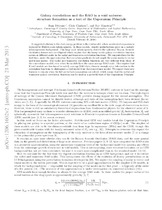| dc.contributor.author | February, Sean | |
| dc.contributor.author | Clarkson, Chris | |
| dc.contributor.author | Maartens, Roy | |
| dc.date.accessioned | 2018-02-15T13:46:24Z | |
| dc.date.available | 2018-02-15T13:46:24Z | |
| dc.date.issued | 2013 | |
| dc.identifier.citation | February, S. et al. (2013). Galaxy correlations and the BAO in a void universe: structure formation as a test of the Copernican Principle. Journal of Cosmology and Astroparticle Physics, 23 | en_US |
| dc.identifier.issn | 1475-7516 | |
| dc.identifier.uri | http://dx.doi.org/10.1088/1475-7516/2013/03/023 | |
| dc.identifier.uri | http://hdl.handle.net/10566/3499 | |
| dc.description.abstract | A suggested solution to the dark energy problem is the void model, where accelerated expansion is
replaced by Hubble-scale inhomogeneity. In these models, density perturbations grow on a radially
inhomogeneous background. This large scale inhomogeneity distorts the spherical Baryon Acoustic
Oscillation feature into an ellipsoid which implies that the bump in the galaxy correlation function
occurs at different scales in the radial and transverse correlation functions. We compute these for the
first time, under the approximation that curvature gradients do not couple the scalar modes to vector
and tensor modes. The radial and transverse correlation functions are very different from those of
the concordance model, even when the models have the same average BAO scale. This implies that
if void models are fine-tuned to satisfy average BAO data, there is enough extra information in the
correlation functions to distinguish a void model from the concordance model. We expect these new
features to remain when the full perturbation equations are solved, which means that the radial and
transverse galaxy correlation functions can be used as a powerful test of the Copernican Principle. | en_US |
| dc.language.iso | en | en_US |
| dc.publisher | IOP Science | en_US |
| dc.rights | This is the pre-print (From arXiv:1206.1602) of the article available online at: http://dx.doi.org/10.1088/1475-7516/2013/03/023 | |
| dc.subject | Galaxies | en_US |
| dc.subject | BAO | en_US |
| dc.subject | Baryon Acoustic Oscillation | en_US |
| dc.subject | Copernican Principle | en_US |
| dc.title | Galaxy correlations and the BAO in a void universe: structure formation as a test of the Copernican Principle | en_US |
| dc.type | Article | en_US |
| dc.privacy.showsubmitter | FALSE | |
| dc.status.ispeerreviewed | TRUE | |
| dc.description.accreditation | Web of Science | |

